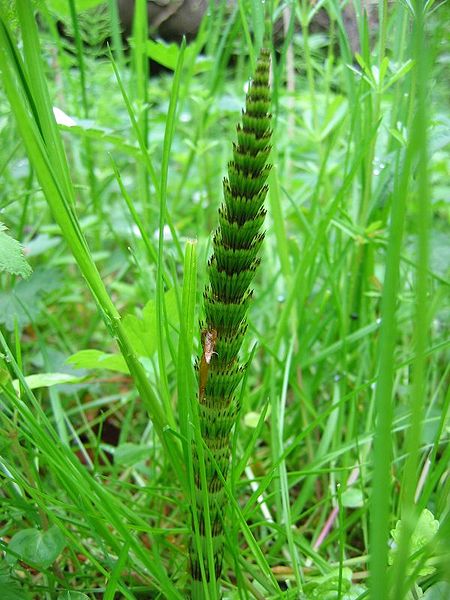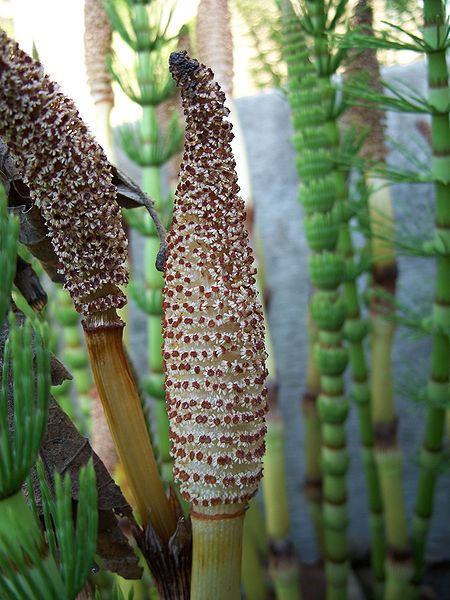 |
|
http://commons.wikimedia.org/wiki/User:Fabelfroh |
 |
| http://commons.wikimedia.org/wiki/User:EugeneZelenko |
Translate this page:
Summary
Equisetum species - horsetail family are Creeping, perenial, Branching rootstocks, rooted at the nodes. The Arial stems may be annual or Perennial, are cylindrical, fluted, simple or with whorled branches at the jointed nodes. The internodes are usually hollow. The Surfaces of the stems are covered with Silica. The Cones are terminal.
Physical Characteristics

 Equisetum telmateia is a PERENNIAL growing to 2 m (6ft 7in).
Equisetum telmateia is a PERENNIAL growing to 2 m (6ft 7in).
See above for USDA hardiness. It is hardy to UK zone 6. It is in flower in March, and the seeds ripen in April.
Suitable for: light (sandy), medium (loamy) and heavy (clay) soils. Suitable pH: mildly acid, neutral and basic (mildly alkaline) soils. It can grow in semi-shade (light woodland) or no shade. It prefers moist soil.
UK Hardiness Map
US Hardiness Map
Synonyms
E. maximum. auct.
Plant Habitats
Woodland Garden Dappled Shade; Shady Edge; Cultivated Beds;
Edible Uses
Edible Parts: Shoots Stem
Edible Uses:
Strobil (the fertile shoots in spring) - raw or cooked[256]. The tough outer fibres are peeled off, or can be chewed and then discarded[256]. The vegetative shoots, produced from late spring onwards, were occasionally cleaned of their leaves, sheathing and branches and then eaten by native North American Indians, but only when very young and tightly compacted[256]. Root - cooked[257].
References More on Edible Uses
Medicinal Uses
Plants For A Future can not take any responsibility for any adverse effects from the use of plants. Always seek advice from a professional before using a plant medicinally.
Astringent Diuretic Poultice
The plant is astringent and diuretic[257]. A decoction has been used to treat 'stoppage of urine'[257]. A poultice of the rough leaves and stems is applied to cuts and sores[257].
References More on Medicinal Uses
The Bookshop: Edible Plant Books
Our Latest books on Perennial Plants For Food Forests and Permaculture Gardens in paperback or digital formats.

Edible Tropical Plants
Food Forest Plants for Hotter Conditions: 250+ Plants For Tropical Food Forests & Permaculture Gardens.
More

Edible Temperate Plants
Plants for Your Food Forest: 500 Plants for Temperate Food Forests & Permaculture Gardens.
More

More Books
PFAF have eight books available in paperback and digital formats. Browse the shop for more information.
Shop Now
Other Uses
Basketry Fungicide Hair Liquid feed Polish Sandpaper
The stems are very rich in silica[4]. They are used for scouring and polishing metal[1, 4, 46, 61, 99, 257] and as a fine sandpaper[54, 99, 257]. The stems are first bleached by repeated wetting and drying in the sun[74]. They can also be used as a polish for wooden floors and furniture[46, 178]. The infused stem is an effective fungicide against mildew, mint rust and blackspot on roses[14]. It also makes a good liquid feed[54]. Used as a hair rinse it can eliminate fleas, lice and mites[213]. The black roots have been used for imbrication on coiled baskets[257].
Special Uses
Dynamic accumulator
References More on Other Uses
Cultivation details
Prefers a moist soil with a pH between 6.5 and 7.5[200]. Plants are hardy to about -30°c[200]. Plants have a deep and penetrating root system and can be invasive. If grown in the garden they are best kept in bounds by planting them in a large container which can be sunk into the ground[200].
References Carbon Farming Information and Carbon Sequestration Information
Temperature Converter
Type a value in the Celsius field to convert the value to Fahrenheit:
Fahrenheit:
The PFAF Bookshop
Plants For A Future have a number of books available in paperback and digital form. Book titles include Edible Plants, Edible Perennials, Edible Trees,Edible Shrubs, Woodland Gardening, and Temperate Food Forest Plants. Our new book is Food Forest Plants For Hotter Conditions (Tropical and Sub-Tropical).
Shop Now
Plant Propagation
Spores - best collected as soon as they are ripe in the spring and surface-sown immediately on a sterile compost. Keep moist and pot up as soon as the plants are large enough to handle. Very difficult[200]. Division. The plants usually spread very freely when well sited and should not really need any assistance.
Other Names
If available other names are mentioned here
Native Range
TEMPERATE ASIA: Iran, Lebanon, Syria, Turkey, Russian Federation-Ciscaucasia (Ciscaucasia), Armenia, Azerbaijan, Georgia, Russian Federation (Dagestan) NORTHERN AMERICA: United States (Alaska, Oregon, Washington, California), Canada (British Columbia) EUROPE: Denmark, United Kingdom, Ireland, Austria, Belgium, Switzerland, Czech Republic, Germany, Hungary, Netherlands, Poland, Slovakia, Lithuania, Latvia, Moldova, Russian Federation (Volgogradskaja oblast), Ukraine (incl. Krym), Albania, Bulgaria, Bosnia and Herzegovina, Greece, Croatia, Italy, North Macedonia, Montenegro, Romania, Serbia, Slovenia, Spain, France, Portugal AFRICA: Algeria, Morocco, Tunisia
Weed Potential
Right plant wrong place. We are currently updating this section.
Please note that a plant may be invasive in one area but may not in your area so it's worth checking.
Conservation Status
IUCN Red List of Threatened Plants Status :

Growth: S = slow M = medium F = fast. Soil: L = light (sandy) M = medium H = heavy (clay). pH: A = acid N = neutral B = basic (alkaline). Shade: F = full shade S = semi-shade N = no shade. Moisture: D = dry M = Moist We = wet Wa = water.
Now available:
Food Forest Plants for Mediterranean Conditions
350+ Perennial Plants For Mediterranean and Drier Food Forests and Permaculture Gardens.
[Paperback and eBook]
This is the third in Plants For A Future's series of plant guides for food forests tailored to
specific climate zones. Following volumes on temperate and tropical ecosystems, this book focuses
on species suited to Mediterranean conditions—regions with hot, dry summers and cool, wet winters,
often facing the added challenge of climate change.
Read More
Expert comment
Author
Ehrh.
Botanical References
17200
Links / References
For a list of references used on this page please go here
Readers comment
© 2010, Plants For A Future. Plants For A Future is a charitable company limited by guarantee, registered in England and Wales. Charity No. 1057719, Company No. 3204567.